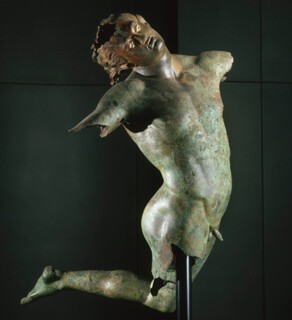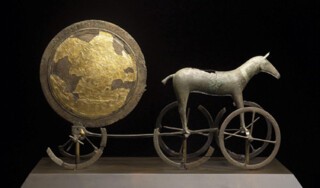‘I’ve done it,’ Horace shouts at the end of his third book of Odes. ‘I’ve made a monument more lasting than bronze … Something that neither biting rain, nor an immeasurable succession of years could cause to crumble.’ Bronze has long been a byword for enduring monumentality, and some of the items on display in the Royal Academy’s exhibition Bronze (until 9 December) are 5700 years old, apparently. They are a small selection from a hoard of ceremonial objects with animal motifs found wrapped in a reed mat in a cave near the Dead Sea in the 1960s.
Other bronze objects fell out of boats – or were they pushed? – at the time when the Romans were busily conquering the Mediterranean, and spent twenty centuries on the seabed in the company of marine organisms, but nevertheless suffered no sea change, immune not merely to biting rain but to deep immersion in saltwater. Indeed so recognisably human were the limbs and facial features poking out through the sand that wonder and amazement were sometimes preceded by horror and fear, when their discoverers thought they had stumbled across a newly deposited corpse in a dumping ground for mafia murderers.
Just such a newly emergent masterpiece fills the first room, the central rotunda of the Royal Academy: the larger than lifesize dancing satyr from Mazara del Vallo, on the southern coast of Sicily, head tossed back in wild wind-ruffled abandonment, back arched, leg kicking, eyeballs white with alabaster. Hauled from the sea in a fisherman’s net in 1998, sea-creatures, reportedly, streaming from the back of his head as he resurfaced, he probably formed part of a larger group of raving bacchants, who first emerged from their foundry in Greece in the decades around 300 BCE. So proud was Mazara of this ancient treasure that on his return from restoration they gave him his own museum, the Museo del Satiro, which when I visited in June was attracting a decent number of visitors; I hope they are not still charging for admission.
The Dancing Satyr is typical of what I think of when I think of ancient bronzes: a thin-skinned balloon of brown-green metal, light and yet strong, self-consciously opposed both to the ‘pitiless bronze’ of ancient weapons and armour, and to the blockish stone sculptures with which they had to share ancient exhibition space, unmalleable marbles that could never imagine kicking back so high and with such abandon, unless the raised leg was supported by a fortuitous tree stump. This same exquisite poise, albeit in more subtle manifestation, is also a feature of the Riace bronzes now housed in Reggio di Calabria, which are described by the present curator David Ekserdjian, nem con, as ‘among the most stupendous works of art in existence’.
Such ballon is achieved through the cire perdue or lost wax technique. This involves making a solid model, usually of wax or wax-finished but sometimes of stone or wood, which is transformed by means of a dialogue of positive and negative images (after each of which modifications can be made and errors corrected) into a hollow wax model with walls just 3 mm or so thick; the wax is melted and drained and replaced with molten bronze. It is a method that requires extreme skill and can easily go horribly wrong – Benvenuto Cellini’s famous account of casting his giant Perseus for the Loggia della Signoria in Florence or Tarkovsky’s terror-stricken bell-maker in Andrei Rublev are not wholly inaccurate testaments to the high stakes involved, but it is also a technique that provides bronze with some surprising flashes of delicacy. On some of Degas’s bronzes, for instance, you can clearly see the artist’s waxen fingerprints, as they once pushed a globule of the soft stuff into position.
Examples of this ancient lightness and irony – untruth to materials – is visible in some of the most recent sculptures in the exhibition, Jeff Koons’s leaden-looking chocolate-coloured bronze basketball, and Jasper Johns’s sarcastically monumental cans of beer, the Americans outclassing the dismal and anonymous contributions from modern British sculptors – where’s Barry Flanagan when you need him? Jake and Dinos Chapman? Antony Gormley RA?
But as I moved around Room 1, which contains perhaps the most far-flung group of human figures ever gathered in close proximity, quite different features of bronze became apparent: its lumpenness, its heavy objectness. Rodin’s wonderful Age of Bronze (originally entitled Le Vaincu) from the V&A has a glossy black patina that gives it the hard slippery look of the surface of the sea at night; not far away is de Kooning’s groggy Clam Digger, a mud-monster. Opposite is a sinister metre-high bowman from Jebba Island, Nigeria, and a very heavily draped Roman discovered in the theatre at Herculaneum; he was, it seems, a former slave who had made himself so useful to the town that they gave him his own statue paid for by public subscription. Between them is the remarkably elongated Etruscan votive statue known as Evening Shadow, a profound influence, one does not need to be told, on Giacometti, and Prieur’s lovely Acrobat Performing a Handstand.
Room 4 meanwhile juxtaposes Giambologna’s rough-textured Turkey displaying its plumage and wattles to feathery fleshly effect alongside Brancusi’s firebird, Maiastra, so smooth and highly polished that it immediately recalls the poor relations of these artworks, the bedknobs and door-handles of the metalmonger’s shop. Such diversity of form, colour and texture makes you wonder if there is anything more peculiar to ‘brazenness’ than there might be to ‘stoneness’ or ‘blueness’, but Room 3 (Animals I) shows the advantages of the single-material approach; as you walk in and look around this not very large space it is not immediately apparent to which epoch any of these marvellous beasts around you might be assigned, so you can enjoy an all-other-things-being-equal conversation between ancient and modern, east and west, an unusual experience not only because museums are rarely so determinedly eclectic, but because in other media there are normally so many other clues – colours, frames and, above all, states of preservation – that provoke the brain to taxonomise immediately and order onto scales of artistic development.
In this room, the curators’ undoubted coup is the loan of the Etruscan Arezzo Chimaera, one of the most famous treasures of Florence’s National Archaeological Museum, but the masterpiece is a horse’s head (the ‘Medici Riccardi Head’), probably Hellenistic or late classical, from the same collection, its surface texture like polished granite. On the other hand, my prize for most delightful sculpture in the room goes to a green Chola Bronze of about 1200 CE from South India, an image of the bull called Nandi, Shiva’s ride, at rest, its cud-chewing smile echoed in concentric circles of jolly jewelled necklaces loosely thrown around his thick neck.
In fact, as the excellent catalogue scrupulously observes, this ‘Chola Bronze’, like the most ancient artefacts from the Dead Sea, is not strictly bronze inasmuch as it lacks the proper admixture of tin, while the ‘Benin Bronzes’ are more properly described as ‘Brass’ – copper and zinc alloy. But the organisers are not much bothered by differences in metallurgical recipes and temporal shifts in conventional terminology and have thankfully resisted the temptation to title the exhibition in conformity with modern scholarly practice Copper Alloy.
Another unusual feature of this exhibition is a relaxed approach to copies. There are not only works that were produced, like lithographs, in limited editions with the artist’s authorisation, like Picasso’s Baboon and Young or Rodin’s Age of Bronze, and copies of original bronzes produced long after the artist’s death, like a massive glossy black replica of Cellini’s greeny-brown original of Perseus with the Head of Medusa, produced in the 19th century for Trentham Gardens with the permission of the Duke of Tuscany, but also bronzes made from models that were never bronzes in the artist’s lifetime, and copies in molten metal of famous carvings in stone. I don’t really see the point, except in the context of the history of collecting and connoisseurship, of transporting from Norfolk to Burlington House a huge glossy black late 17th-century copy of the Vatican’s Laocöon and then sticking it in a cramped cul-de-sac of the exhibition space, or finding room for Soldani’s copies of Michelangelo’s Bacchus and Bernini’s Damned Soul. Couldn’t we rather have had one example of a church bell – where the recipe for bronze makes a very great difference to the timbre – or a copy of one of the magnificent bronze doors of the Middle Ages? The V&A has got copies of some of the finest examples in the world.
But reproduction is an inherent feature of bronze-casting, Carol Mattusch argues in her contribution to the catalogue, and it is likely that even those works we revere as exceptional masterpieces, like the Riace bronzes, were, in part at least, the work of anonymous foundry labourers starting with a basic mould and modifying the wax working model derived from it, before adding individuating details of hair and facial expression – not so exceptional after all. The sheer quantity of bronze statuary littering the public and private spaces of the ancient world, described by several ancient authors and confirmed by modern excavations at Olympia, Delphi and, for example, the Villa of the Papyri at Herculaneum, means that this must have been so.
It must also mean that inasmuch as they represent a microscopic percentage of the bronzes that were around in antiquity, the handful that have survived to the present day are very unlikely to have been elite commissions created by famous names, certainly not the well-achieved Freedman from Herculaneum, nor the Dancing Satyr, nor possibly even the Riace bronzes; these may all be no more than public-space fillers made by journeyman blacksmiths. There is one exception, however, which arrives only in the final room, Room 10, devoted to ‘Heads’. Uncovered only in 2004 in Bulgaria, metres away from a royal tomb, it is a portrait head probably of Seuthes III, king of Thrace, commissioned from an Athenian artist around 300 BCE. It is extremely particular, neither standardised nor idealised, a small expanse of smooth face, a hooked nose, surrounded by separately created locks of hair and ungroomed beard, and centred on an intense slightly cross stare made of glass paste, alabaster ‘and eyelashes of warm-coloured copper’. It took me totally by surprise, like coming across a more intense and lived-in version of Brian Blessed, decapitated in a vitrine. But until this June I had been unfamiliar with the Dancing Satyr also, and chances are that further masterpieces will turn up in similar fashion in the not too distant future, fresh as the day they left the foundry.
In other words we must still reserve judgment on Horace’s assertion about longevity and his third book of Odes. I wish him the best and I have every faith in him; I would hate to think he might ever be forgotten. But ‘more lasting than bronze’? It is far too soon to tell.
Send Letters To:
The Editor
London Review of Books,
28 Little Russell Street
London, WC1A 2HN
letters@lrb.co.uk
Please include name, address, and a telephone number.



